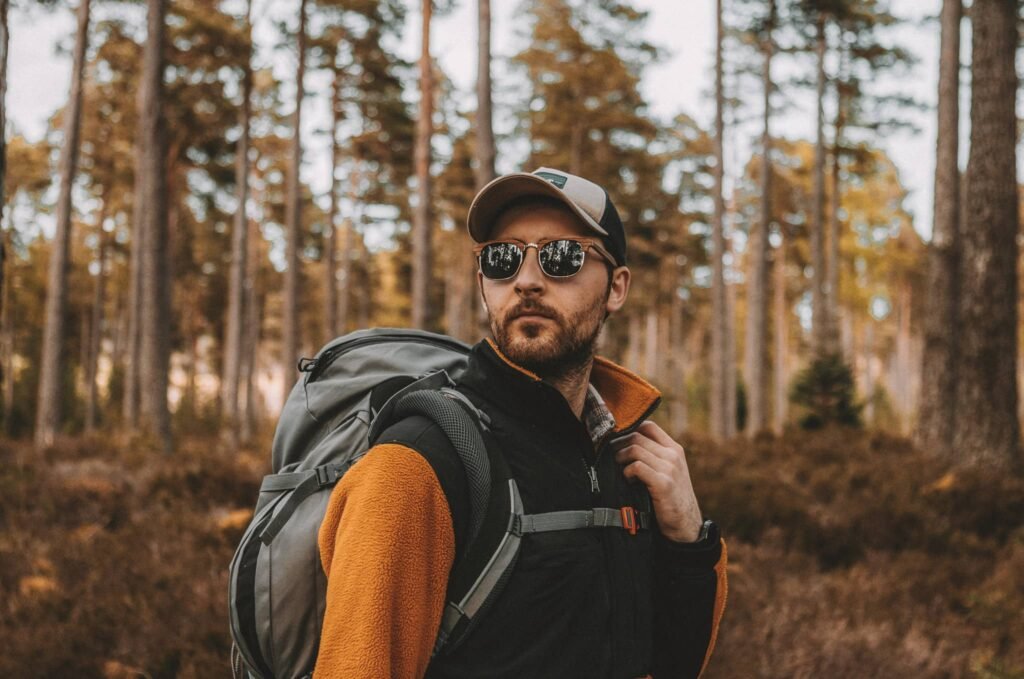Are you looking for the best hiking sunglasses, but unsure what features to look for?
More and more people are stepping outside for recreation. According to the Outdoor Industry Association (OIA), participation rates have grown for the eighth consecutive year. Hiking is the most popular activity, with 881,000 new hikers in 2022 alone.
However, hiking, especially at high altitudes, carries increased eye-related risks such as sun damage, glare, and other visibility issues. The OIA also considers hiking a ‘gateway activity,’ meaning it’s the first step people take before delving into more niche outdoor activities.
If you’ve recently fallen in love with hiking and want to make it a habit, investing in a good pair of hiking sunglasses can go a long way for hiking and even related activities like mountaineering, canyoneering, and more.
Here’s how the right sunglasses can be your best friend on the trail.
The Benefits of Using Proper Hiking Sunglasses
Hiking sunglasses aren’t just a fashion accessory—the right pair can boost your safety, vision, and protection from the elements, providing an overall better experience. The benefits of using these are as follows:
- Protects Your Eyes: Hiking sunglasses with UV protection can help protect your eyes from harmful ultraviolet rays. Over time, this reduces the risk of eye damage and conditions like cataracts and macular degeneration.
- Improves Visibility: When equipped with polarized lenses, sunglasses can significantly reduce glare from reflective surfaces commonly seen on a hike, like water, snow, and rocks. This enhances visibility and prevents eye strain.
- Enhances Safety: They can enhance contrast and clarity. This improves your safety on your journey, as the sunglasses allow you to see essential signs and trail markers. With enhanced contrast, you can spot camouflaged animals better.
- Sharpens Contrasts: Depending on the tint of the lenses, they can serve additional functional purposes. A few examples: yellow tints are ideal for low-light conditions, while dark green lenses, used originally by pilots, reduce brightness at higher altitudes while maintaining color contrast.
- Protects From Dirt: Depending on the frame shape, they can help protect your eyes from dust, debris, and insects to prevent irritation. Wraparound designs or frames with edges that hug the eyes are ideal for this.
- Boosts Endurance: Finally, they can minimize long-term eye fatigue, allowing you to hike longer and with greater comfort, even under intense environmental conditions.
Different hikers prefer different trails, influencing the features you need in your eyewear.
Hikers trudging through dense forests with poor depth perception will have a different pair than someone conquering dusty and sandy desert environments. For this reason, consider your personal needs, preferences, and hiking destinations when selecting hiking sunglasses.
The Top 5 Features Your Hiking Sunglasses Should Have
There’s no need to panic if you haven’t shopped for a pair of hiking glasses before. They’re similar to sunglasses, although you’d want to pay attention to specific specs and ensure your new shades are hiking-appropriate.
Here are the five features you need to keep an eye on before making your purchase:
1. Polarized lenses
When hiking, you can be temporarily blinded by light and glare reflecting from nearby bodies of water or snow. On unfamiliar and uneven terrain, a moment of blindness can mean injury.

To avoid this safety hazard, look for polarized sunglasses with the latest technologies to protect your eyes while topping your hiking look.
Sport performance shades like the Oakley Radar EV Path feature a taller lens for an extended range of view, plus a wraparound design and performance shield lens technology for multi-directional protection.
These can be outfitted with polarized Prizm lenses to enhance color for better visibility. Polarized lenses help you see obstacles and terrain changes more clearly to stay safe on the trail.
2. Enhanced durability
Good quality sunglasses are an investment, even more so in damage-prone applications like hiking. You want a pair that can withstand the elements and those unexpected drops, scratches, and dings.

For this, the Ombraz Classic armless sunglasses have no side arms or hinges; instead, they have an easily adjustable marine-grade cord. They can lie flat so that they can be easily stored in a backpack or back pocket.
The less breakable parts mean a higher likelihood of durability. More robust pairs are ideal for advanced hikers facing more intense obstacles. Plus, the adjustable cord means you can wear them around your neck when not in use.
This way, you don’t misplace them during a trail break.
3. Lightweight frames
If you’re exploring expansive trails like the North American East Coast, there could be tens, if not hundreds, of kilometers between your designated points A and B.

Every ounce you pack counts, but you want to stay light without compromising protection. A pair of lightweight sunglasses like the Maui Jim Wailua is only 0.500 ounces (14.1 grams), thanks to its MauiPure lens that weighs the same as a CD.
Adjustable nose pads provide additional support and comfort for all-day wear. A comfortable pair of sunglasses means you’re more likely to keep them on and stay protected.
4. Smart features
The era of smart sports performance eyewear is here, and some first adopters may want to take a piece of this technology to make their hikes more efficient.
The LeMuna smart glasses feature built-in speakers and mics for hands-free communication and music listening. This can enhance your hiking experience. Its IP56 waterproof rating protects it from sweat and splashes, and its Bluetooth support allows for seamless connectivity.
Hands-free communication features are helpful in case of falls or injury. This allows you to call for help if you run into trouble.
While these wearable technologies are relatively new, they’re worth looking out for if you’re an experienced hiker.
5. Interchangeable looks
Hiking is all about minimalism: any extra weight becomes a literal burden, so seasoned hikers learn to live with less, even outside the hobby. Having hiking sunglasses that can seamlessly go from mountain to city is a plus.

The Julbo Cham mountaineering sunglasses have a durable metal frame that generations of adventurers have extensively tested. They can be changed into fashionable aviators on city streets when not hiking.
Versatile equipment is a must when hiking, and having one pair for everything lessens the likelihood of you leaving them at home.
Maintenance Tips for Your Hiking Sunglasses
Given that hiking sunglasses are an investment to protect your eyes, they require maintenance and TLC, so you can use them for a long time.
Clean Your Glasses Correctly
Before leaving for a hike, cleaning your sunglasses at home is best. For a thorough cleanse, use cold or tepid water and liquid soap, washing liquid, or a cleaning spray formulated for glasses.
Hot water may damage your glasses and lens coatings due to thermal shock. At the same time, household cleaning products like disinfectants or acetone can also strip away those vital lens coatings.
A drop of gentle dish soap on each lens can help remove body oils from screws and joints but do rinse your glasses thoroughly after.
A microfiber cloth would be the best tool to clean dust, dirt, and grime off areas such as the nose bridge and stems. Avoid using a t-shirt, paper towel, or fabric with lint on it to wipe your glasses dry, as these will easily scratch your lenses.
Of course, you will also need to clean and maintain your shades while you’re on the hike – and that can prove to be more challenging as you sweat throughout the day and encounter all sorts of elements.
Store Them Well
When not in use, keep your sunglasses in a padded, protective case inside your hiking backpack. This is to minimize damage due to impact, scratches, or dirt.
If you’d like to take them on and off throughout the day, keep them on straps around your neck so they don’t fall off or get lost; avoid placing your sunglasses on top of your head, as this habit can stretch out the frames and cause misalignment.
Use the Right Products
Don’t use harsh chemicals or abrasive materials because these can damage the lens coatings or frame finishes. This applies to normal eyeglasses you bring on your trip as well.
If your sunglasses have stubborn stains or grime—like hiking under muddy conditions—a small bottle of lens cleaning solution or pre-moistened lens wipes could be more efficient than rinsing off.
After cleaning, don’t forget to put your sunglasses back in their protective case. This is to keep them safe and secure until you need them again.
On the hike, your hands are probably covered in dust or sweat. Ensure your hands are as clean as possible before you clean your lenses. Pack a microfiber cloth inside your sunglasses case; ideally, this cloth is designed specifically for the eyewear you have.
Now, gently wipe away any dirt and smudges. If there’s water available, you can rinse your sunglasses under a gentle stream to remove any larger debris. Do this before wiping your eyewear dry with the cloth.
Conclusion
Hiking sunglasses are indispensable for a safe, efficient, enjoyable hiking experience. With protection from glare and UV damage plus additional features, you’ll make it to the end of your trail easily—and in style.
And that’s it!
If you liked this article, check out my article on the most important hiking essentials to bring with you on any trail.
Author Bio: Aaron Fields is a freelance writer passionate about the outdoors. He hopes to inspire more people to ditch the screens and experience nature. He is passionate about environmental conservation and believes getting more people serious about the environment is the only way to get them outside. Aside from hiking, he also loves to sail.